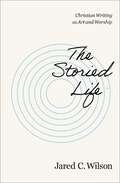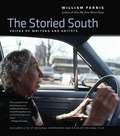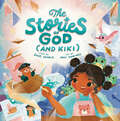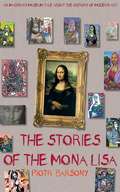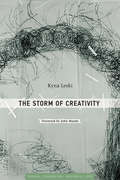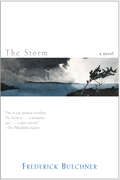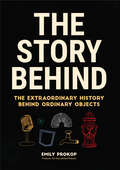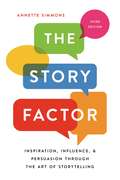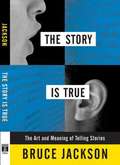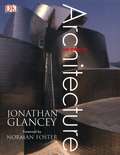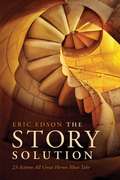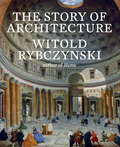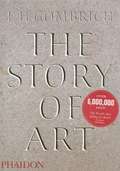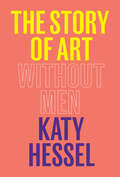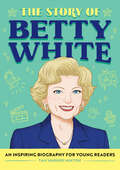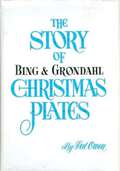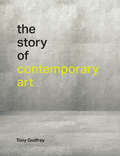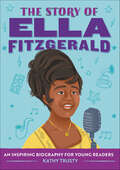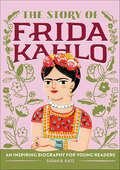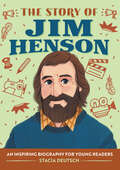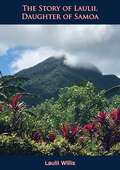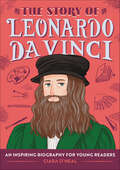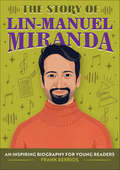- Table View
- List View
The Storied Life: Christian Writing as Art and Worship
by Jared C. WilsonWhen writers write, they are getting in touch with the image of God in them. This is true in some way of all artistry, but writers especially create worlds, characters, histories, and transformation--all ex nihilo ("out of nothing").In The Storied Life, veteran author Jared C. Wilson explores the ins and outs of writers and writing, exploring the myriad ways the craft is more about transformation than simply communication. From decades of experience and with his signature wit, Wilson brings well-earned insight, autobiographical reflections, and meaningful meditations to the topic of writing as a way of life and as a way of worship, showing how the concept of Story--our personal stories and God's grand story of redemption--shapes fiction and non-fiction writers alike.Chapters focus on topics like:The liturgy of story.Writing as a spiritual act.Perseverance and endurance.Writing as a calling.Promotion, publishing, and platform.Whether you're a long-time writer or a beginning author, a daily journaler or an occasional dabbler, The Storied Life will help you improve your craft. It will lead you to think more deeply about the disciplines and dispositions needed to write for transformation.
The Storied South
by William FerrisThe Storied South features the voices--by turn searching and honest, coy and scathing--of twenty-six of the most luminous artists and thinkers in the American cultural firmament, from Eudora Welty, Pete Seeger, and Alice Walker to William Eggleston, Bobby Rush, and C. Vann Woodward. Masterfully drawn from one-on-one interviews conducted by renowned folklorist William Ferris over the past forty years, the book reveals how storytelling is viscerally tied to southern identity and how the work of these southern or southern-inspired creators has shaped the way Americans think and talk about the South.The Storied South offers a unique, intimate opportunity to sit at the table with these men and women and learn how they worked and how they perceived their art. The volume also features 45 of Ferris's striking photographic portraits of the speakers and a CD and a DVD of original audio and films of the interviews.
The Stories Shoes Tell (Fountas & Pinnell LLI Purple #Level U)
by Nancy WhiteShoes talk. From athletic shoes to five-inch heels, from baseball cleats to flip-flops, the kinds of shoes people wear say a lot about who they are and who they want to be. Even shoes from thousands of years ago have stories to tell about the people who wore them.
The Stories of God (Made in His Image)
by Dave ConnisFrom the creators of The Inventions of God (and Eva) comes a delightfully illustrated picture book that tells the story of would-be author and artist Kiki—and the God who created her to be a lot like Him.Little Kiki is an aspiring author and illustrator who weaves daring tales about swashbuckling otters, all-knowing sea cucumbers, and nail-biting rescues from the clutches of gerblins (part gerbil, part goblin). But where do her imagination, creativity, and ideas come from? Meet God, the author of all stories. He writes adventurous tales such as Esther Saves Her Family and Friends, Jesus and the Tomb that Couldn&’t Hold Him, and the Story of Kiki. Kiki loves to write but sometimes she forgets to include important pieces (like the time she forgot to give the ship&’s cook a kitchen). God also loves to write, and He knows exactly what every story needs. They are both writing their biggest story of all, and the endings are bound to be incredible. Children and parents alike will delight in the playful illustrations, imaginative side stories, and the gentle reminder that the image of God is alive in each of us.
The Stories of the Mona Lisa
by Piotr Barsony"Dad, will you tell me a story?" asks a little girl. "Sure," artist Piotr Barsony responds. "I'll tell you a story about a painting. And the Mona Lisa, the most beautiful painting in all the world, will be our subject." Thus begins the fascinating history of modern painting through what many consider the most famous work in the history of art: the Mona Lisa by Léonardo De Vinci. Piotr acts as the museum guide for his young daughter throughout the book, taking us on a journey through an imaginary museum. He describes famous art movements and artists, including: impressionism, cubism, expressionism, favism, minimalism, surrealism; Monet, Manet, Cézanne, Picasso, Bacon, Pollock, and more. All of the most famous painters of the modern and contemporary art movements are explained with their own Mona Lisa portraits, in their signature styles.Throughout the book, Piotr acts as a guide, explaining to his daughter (and the reader) each genre of paintings in a clear, simple, and entertaining way. By the end of the book, we discover that he's actually the artist who's been painting all those Mona Lisas--and the results are spectacular. The Stories of the Mona Lisa is the perfect book for any child who loves art, history, and a good story.
The Storm of Creativity (Simplicity: Design, Technology, Business, Life)
by Kyna LeskiThe stages of the creative process—from “unlearning” to beginning again—seen through examples from the practice of artists, architects, poets, and others. Although each instance of creativity is singular and specific, Kyna Leski tells us, the creative process is universal. Artists, architects, poets, inventors, scientists, and others all navigate the same stages of the process in order to discover something that does not yet exist. All of us must work our way through the empty page, the blank screen, writer's block, confusion, chaos, and doubt. In this book, Leski draws from her observations and experiences as a teacher, student, maker, writer, and architect to describe the workings of the creative process. Leski sees the creative process as being like a storm; it slowly begins to gather and take form until it overtakes us—if we are willing to let it. It is dynamic, continually in motion; it starts, stops, rages and abates, ebbs and flows. In illustrations that accompany each chapter, she maps the arc of the creative process by tracing the path of water droplets traveling the stages of a storm.Leski describes unlearning, ridding ourselves of preconceptions; only when we realize what we don't know can we pose the problem that we need to solve. We gather evidence—with notebook jottings, research, the collection of objects—propelling the process. We perceive and conceive; we look ahead without knowing where we are going; we make connections. We pause, retreat, and stop, only to start again. To illustrate these stages of the process, Leski draws on examples of creative practice that range from Paul Klee to Steve Jobs, from the discovery of continental drift to the design of Antoni Gaudí's Sagrada Familia. Creativity, Leski tells us, is a path with no beginning or end; it is ongoing. This revelatory view of the creative process will be an essential guide for anyone engaged in creative discovery. The Creative Process Unlearning Problem Making Gathering and Tracking Propelling Perceiving and Conceiving Seeing Ahead Connecting Pausing Continuing
The Storm: A Novel
by Frederick BuechnerThe Boston Globe calls Frederick Buechner "one of our finest writers." USA Today says he's "one of our most original storytellers." Now this acclaimed author gives us his most beguiling novel yet--a magical tale of love, betrayal, and redemption inspired by Shakespeare's The Tempest.On wealthy Plantation Island in South Florida, an old man waits, Kenzie Maxwell is a writer, a raconteur, a rascal, an altruist, a mystic--a charismatic figure who enjoys life with his rich third wife but muses daily on the sins of his past. Two decades ago, Kenzie had to leave New York because of a scandal. He'd been a volunteer at a runawat shelter, and he'd fallen in love with a seventeen-year-old girl--a girl who died while giving birth to Kenzie's daughter. His older brother, Dalton, a lawyer and board member at the shelter, decided to quell the rumors by releasing Kenzie's note of apology to the press. Kenzie's reputation--and the girl's--were destroyed. He has never forgiven his brother.Now it's the eve of Kenzie's seventieth birthday, and a storm is brewing. His beloved daughter, Bree--the child of the scandal--is coming down from New York for his birthday party. But his brother Dalton is coming down, too, to do some legal work for the island's ill-tempered matriarch. Aided and abetted by Dalton's happy-go-lucky stepson, a loutish gardener, a New Age windsurfer, a bumbling bishop, and a bona fide tempest, Kenzie must somehow contrive to reconcile with his brother--and make peace with his past.Infused with humanity, and informed by faith. The Storm is Frederick Buechner's most captivating novel since Godric--a richly satisfying contemporary story of fragmented families and love's many mysteries that will move you, makeyou laugh, and fill you with wonder.
The Story Behind: The Extraordinary History Behind Ordinary Objects (Story Behind Ser.)
by Emily ProkopLearn the fascinating history and trivia behind the everyday items we take for granted—from the host of the popular podcast The Story Behind. Many of us learn about the major inventions that shape our world. But we too often overlook the objects we use every day. In The Story Behind, Emily Prokop, creator of the Webby Award nominated podcast, explores the who, how, and huh? of everything from Band-Aids to bubble gum; hypnosis to Hula Hoops; and lullabies to lead pipes. Along the way, she demonstrates how the major events of history—from wars, plagues, and revolutions to historic achievements and discoveries—have influenced some of the world&’s most pervasive inventions. Revealing fascinating new details on topics covered in the podcast, the book also explores many new subjects. Learn how lollipops got started in ancient Egypt, how Kevlar came to be, and why Comic Sans was created. Learn the torture device origins of certain exercise equipment and how some musical instruments were first developed for espionage. From food, fashion, and games to transit and modern technology, The Story Behind offers a closer look at the things closest to us.
The Story Factor: Inspiration, Influence, and Persuasion through the Art of Storytelling
by Annette SimmonsFully revised, updated, and expanded, this modern classic will teach you to use the art of storytelling to persuade, motivate, and inspire in life and business Anyone seeking to influence others must first know their own story, and how to tell it properly. Whether you're proposing a risky new venture, trying to close a deal, or leading a charge against injustice, you have a story to tell. Tell it well and you will create a shared experience with your listeners that can have profound results.In this modern classic, Annette Simmons reminds us that the oldest tool of influence is also the most powerful. Fully revised and updated to account for new technology and social media, along with two new chapters on the role of stories in the development of civilization and how to adjust your story to your specific goal, Simmons showcases over a hundred examples of effective storytelling drawn from the front lines of business and government, as well as myths, fables, and parables from around the world. Whether writing a screenplay, or announcing a corporate reorganization, Simmons illustrates how story can be used in ways that cold facts, bullet points, and directives can't. These stories, combined with practical storytelling techniques, show anyone how to become a more effective communicator and achieve their goals.
The Story Is True: The Art and Meaning of Telling Stories
by Bruce JacksonMaking and experiencing stories, remembering and retelling them is something we all do. We tell stories over meals, at the water cooler, and to both friends and strangers. But how do stories work? What is it about telling and listening to stories that unites us? And, importantly, how do we change them-and how do they change us? InThe Story Is True, author, filmmaker, and photographer Bruce Jackson explores the ways we use the stories that become a central part of our public and private lives. He examines, as no one before has, how stories narrate and bring meaning to our lives, by describing and explaining how stories are made and used. The perspectives shared in this engaging book come from the tellers, writers, filmmakers, listeners, and watchers who create and consume stories. Jackson writes about his family and friends, acquaintances and experiences, focusing on more than a dozen personal stories, from oral histories, such as conversations the author had with poet Steven Spender, to public stories, such as what happened when Bob Dylan "went electric"at the 1965 Newport Folk Festival. Jackson also investigates how "words can kill," showing how diction can be an administrator of death, as in Nazi extermination camps. And finally, he considers the way lies come to resemble truth, showing how the stories we tell, whether true or not, resemble truth to the teller. Ultimately,The Story Is Trueis about the place of stories-fiction or real-and the impact they have on the lives of each one of us.
The Story Of Architecture
by Jonathan GlanceyGuiding readers through a staggering 5,000 years of world architecture, Jonathan Glancey's eminently knowledgeable, authoritative, and always fascinating insights make reading this book irresistible, despite the enormity of the subject. Featuring influential and innovative architects of every age, along with their masterpieces, from the ziggurat at Ur to the Guggenheim Museum in Bilbao, this stylish, lavishly illustrated book shows the unique historical, geographical, and cultural elements that have influenced and literally shaped the world's greatest architecture.
The Story Solution: 23 Actions All Great Heroes Must Take
by Eric EdsonEric Edson has developed a new tool for bringing depth and passion to any screenplay - the ""23 Steps All Great Heroes Must Take."" It's an easy to understand paradigm that provides writers and filmmakers the interconnecting, powerful storytelling elements they need. With true insight, a master teacher of screenwriting pinpoints the story structure reasons most new spec scripts don't sell; then uses scores of examples from popular hit movies to present, step by step, his revolutionary Hero Goal Sequences blueprint for writing blockbuster movies.
The Story of Architecture
by Witold RybczynskiAn inviting exploration of architecture across cultures and centuries by one of the field’s eminent authorsIn this sweeping history, from the Stone Age to the present day, Witold Rybczynski shows how architectural ideals have been affected by technological, economic, and social changes—and by changes in taste. The host of examples ranges from places of worship such as Hagia Sophia and Brunelleschi’s Duomo to living spaces such as the Katsura Imperial Villa and the Alhambra, national icons such as the Lincoln Memorial and the Sydney Opera House, and skyscrapers such as the Seagram Building and Beijing’s CCTV headquarters. Rybczynski’s narrative emphasizes the ways that buildings across time and space are united by the human desire for order, meaning, and beauty. This is the story of architecture’s physical manifestation of the universal aspiration to celebrate, honor, and commemorate, and an exploration of the ways that each building is a unique product of patrons, architects, and builders. Firm in opinion, even-handed, and rooted in scholarship, this book will delight anyone interested in understanding the buildings they use, visit, and pass by each day.
The Story of Art (16th edition)
by E. H. GombrichThis text is the 16th revised and updated edition of this introduction to art, from the earliest cave paintings to experimental art. Eight new artists from the modern period have been introduced. They are: Corot, Kollwitz, Nolde, de Chirico, Brancussi, Magritte, Nicolson and Morandi. A sequence of new "endings" have been added, and the captions are now fuller, including the medium and dimension of the works illustrated. [This text is listed as an example that meets Common Core Standards in English language arts in grades 9-10 at http://www.corestandards.org.]
The Story of Art Without Men
by Katy HesselThe story of art as it’s never been told before, from the Renaissance to the present day, with more than 300 works of art. <p><p>How many women artists do you know? Who makes art history? Did women even work as artists before the twentieth century? And what is the Baroque anyway? <p><p>Guided by Katy Hessel, art historian and founder of @thegreatwomenartists, discover the glittering paintings by Sofonisba Anguissola of the Renaissance, the radical work of Harriet Powers in the nineteenth-century United States and the artist who really invented the “readymade.” Explore the Dutch Golden Age, the astonishing work of postwar artists in Latin America, and the women defining art in the 2020s. Have your sense of art history overturned and your eyes opened to many art forms often ignored or dismissed. From the Cornish coast to Manhattan, Nigeria to Japan, this is the history of art as it’s never been told before. <p> <b>New York Times Bestseller</b>
The Story of Betty White: An Inspiring Biography for Young Readers (The Story of Biographies)
by Tam MintonDiscover the life of Betty White—a story about confidence, imagination, and being silly for young readers ages 6 to 9Betty White was a comedian, producer, and TV star. Before she became famous, she was a little girl in California who loved animals and wanted to be a park ranger. She worked hard to become one of the first women to star in her own TV show, and played many characters who did things differently. Explore how she went from driving trucks during World War II, to being a beloved celebrity—even into her nineties!Independent reading—This Betty White biography is broken down into short chapters and simple language so young readers 6 to 9 can learn on their own.Critical thinking—Kids will learn the Who, What, Where, When, Why, and How of Betty's life, find definitions of new words, discussion questions, and more.A lasting legacy—Find out how Betty's kindness, curiosity, and daring made her a talented performer and inspired others to change their thinking.How will Betty's bravery and humor inspire you?Discover activists, artists, athletes, and more from all across history with the rest of the Story Of series, including famous figures like: Amelia Earhart, Jane Goodall, Eliza Hamilton, Simone Biles, and Misty Copeland.
The Story of Bing And Grondahl Christmas Plates
by Pat Owen Ole SimonsenCreated in 1895, the idea of Christmas plate originated with Harald Bing, owner of Bing & Grøndahl, who hired Swedish artist Frans August Hallin to create the motif. Hallin's technique of cutting the motif for the plate in relief created a very detailed expression. The first motif was the Copenhagen skyline.“Many, many years ago the wealthy people of Europe started a Christmas custom of giving to each of their servants a platter heaped with fruit, cookies, candies and other good things to eat. At first the platter was probably a crude thing of wood, and very little thought was given to it. The rich focused their attention on the contents of the tray, hoping to bring a little cheer into the lives of the recipients by giving them especially good things to eat around the holiday season.The servants looked forward each Christmas to receiving their gifts. Since these people had few things in their homes which were not utilitarian, perhaps it was only natural that they began hanging the platters on their walls after the food was eaten. They referred to these platters as their “Christmas Plates.”Later the servants of one family started showing their Christmas Plates to the servants of other households. When the employers realized that there was rivalry among the servants of the various households regarding who received the most beautiful plates, they began giving more consideration to the platter itself. Eventually beautiful platters were made of many materials, such as metal, wood and pottery. They were sometimes elaborately carved or decoratively painted. In fact, the wealthy, in an effort to outdo each other, commenced devoting more attention to the plate itself than to its contents. Later they started dating each platter so that it would be easy to see which year each had been given. Thus began the custom of making and collecting Christmas Plates.”-Preface
The Story of Contemporary Art
by Tony GodfreyAn instant classic--a lively new introduction to contemporary art that stretches from Andy Warhol's Brillo boxes to Marina Abramović's performance art to today's biennale circuit and million-dollar auctions.Encountering a work of contemporary art, a viewer might ask, "What does it mean?" "Is it really art?" and "Why does it cost so much?" These are not the questions that E. H. Gombrich set out to answer in his magisterial The Story of Art. Contemporary art seems totally unlike what came before it, departing from the road map supplied by Raphael, Dürer, Rembrandt, and other European masters. In The Story of Contemporary Art, Tony Godfrey picks up where Gombrich left off, offering a lively introduction to contemporary art that stretches from Andy Warhol's Brillo boxes to Marina Abramović's performance art to today's biennale circuit and million-dollar auctions. Godfrey, a curator and writer on contemporary art, chronicles important developments in pop art, minimalism, conceptualism, installation art, performance art, and beyond.
The Story of Drawing: An Alternative History of Art
by Susan OwensDrawing is at the heart of human creativity. The most democratic form of art-making, it requires nothing more than a plain surface and a stub of pencil, a piece of chalk or an inky brush. Our prehistoric ancestors drew with natural pigments on the walls of caves, and every subsequent culture has practised drawing – whether on papyrus, parchment or paper. Artists throughout history have used drawing as part of the creative process.While painting and sculpture have been shaped heavily by money and influence, drawing has always offered extraordinary creative latitude. Here we see the artist at his or her most unguarded. Susan Owens offers a glimpse over artists&’ shoulders – from Michelangelo, Rembrandt and Hokusai to Van Gogh, Käthe Kollwitz and Yayoi Kusama – as they work, think and innovate, as they scrutinise the world around them or escape into their imaginations.The Story of Drawing loops around the established history of art, sometimes staying close, at other times diving into exhilarating and altogether less familiar territory.
The Story of Ella Fitzgerald: An Inspiring Biography for Young Readers (The Story of Biographies)
by Kathy TrustyDiscover the life of Ella Fitzgerald—a story about finding your voice for kids ages 6 to 9 Ella Fitzgerald was one of the greatest singers of all time. Before she found her voice and changed the world of jazz music, she was a playful girl who wanted to become a dancer. Her life changed when people started noticing her beautiful singing voice, and she was hired as a singer in a famous jazz band. Explore how Ella went from being a young girl growing up in New York to an award-winning artist who made musical history.Independent reading—This Ella Fitzgerald biography is broken down into short chapters and simple language so kids 6 to 9 can read and learn on their own.Critical thinking—Kids will learn the Who, What, Where, When, Why, and How of Ella's life, find definitions of new words, discussion questions, and more.A lasting legacy—Find out how Ella's impact on music and culture is still felt today.How will Ella's persistence and incredible talent inspire you?Discover activists, artists, and athletes, and more from across history with the rest of The Story Of series - including famous figures like: Katherine Johnson, Simone Biles, Jackie Robinson, Maya Angelou, and Michelle Obama.
The Story of Frida Kahlo: An Inspiring Biography for Young Readers (The Story Of)
by Susan B. KatzDiscover the life of Frida Kahlo—a story about strength, creativity, and never giving up for kids ages 6 to 9Frida Kahlo is one of the most famous and celebrated artists who has ever lived. Before she made history with her beautiful paintings and brave spirit, she went through a life-changing accident that would have made many people want to give up. Instead, Frida fought to overcome her setbacks and follow her passions. In this Frida Kahlo children's book, you'll explore how Frida went from being a young girl in a small Mexican town to an artist who is beloved all around the world.Independent reading—This Frida Kahlo biography is broken down into short chapters and simple language so kids 6 to 9 can read and learn on their own.Critical thinking—Kids will learn the Who, What, Where, When, Why, and How of Frida's life, find definitions of new words, discussion questions, and more.A lasting legacy—Find out how Frida inspired the world with her unique and colorful paintings, as well as her strength of character. How will Frida's creativity and can-do attitude inspire you?Discover activists, artists, athletes, and more from across history with the rest of the Story Of series, including famous figures like: Marie Curie, Selena Quintanilla, Amelia Earhart, Helen Keller, and Jane Goodall.
The Story of Jim Henson: An Inspiring Biography for Young Readers (The Story of Biographies)
by Stacia DeutschDiscover the life of Jim Henson—a story about being creative and trying new things for kids ages 6 to 9Jim Henson was the talented puppeteer who made some of the most famous puppets of all time—the Muppets. Before he created Big Bird, Kermit the Frog, Miss Piggy, Oscar the Grouch, and many other well-known characters, Jim was an ambitious kid who loved trying new things and using his imagination. He learned how to make puppets and went on to invent new ways in which puppets could be used in TV and movies.Explore how Jim Henson went from being a creative young boy growing up in Mississippi to an award-winning writer, director, and puppeteer loved by the entire world.Independent reading—This Jim Henson biography is broken down into short chapters and simple language so kids 6 to 9 can read and learn on their own.Critical thinking—Kids will learn the Who, What, Where, When, Why, and How of Jim's life, find definitions of new words, discussion questions, and more.A lasting legacy—Learn more about how Jim Henson created lasting change in the world of puppets and in the lives of so many kids.How will Jim's big imagination inspire you?Discover activists, artists, athletes, and more from across history with the rest of the Story Of series, including famous figures like: Fred Rogers, Walt Disney, Stan Lee, Lin-Manuel Miranda, and Albert Einstein.
The Story of Laulii, Daughter of Samoa: Daughter Of Samoa ... Also A Sketch Of The Life Of Alexander A. Willis
by Laulii WillisThis autobiography of a 19th-century Samoan woman, with a description of the domestic customs, habits, amusements and legends of her native land, is one of the earliest native Samoan narratives.
The Story of Leonardo da Vinci: An Inspiring Biography for Young Readers (The Story of Biographies)
by Ciara O'NealDiscover the life of Leonardo da Vinci—a story about uncovering new things for kids ages 6 to 9Leonardo da Vinci was a famous artist and thinker. He created well-known paintings like the Mona Lisa and The Last Supper, and even had ideas for modern-day inventions like cars and contact lenses. Before he amazed the world with his creative mind, he was a bright kid who loved asking questions.As a teenager, he studied under an expert artist who taught him different ways to create, like painting and sculpting. Explore how Leonardo went from being a thoughtful young boy to an artistic genius whose artwork still hangs in museums all over the world.Independent reading—This Leonardo da Vinci biography is broken down into short chapters and simple language so kids 6 to 9 can read and learn on their own.Critical thinking—Kids will learn the Who, What, Where, When, Why, and How of Leonardo da Vinci's life, find definitions of new words, discussion questions, and more.A lasting legacy—Discover more about how Leonardo da Vinci changed the world for future generations, including you!How will Leonardo's unstoppable imagination inspire you?Discover activists, artists, athletes, and more from across history with the rest of the Story Of series, including famous figures like: Pablo Picasso, Frida Kahlo, the Wright Brothers, Marie Curie, and Albert Einstein.
The Story of Lin-Manuel Miranda: An Inspiring Biography for Young Readers (The Story of Biographies)
by Frank BerriosDiscover the life of Lin-Manuel Miranda—a story about creating change through art, for kids ages 6 to 9 Lin-Manuel Miranda is an award-winning composer, actor, and playwright—best known for the hit musical Hamilton, which he created! Before he changed the world of entertainment, Lin-Manuel was an intelligent young boy who loved music and musicals. He was inspired to write his own songs and plays, and his life changed when the plays he wrote became huge successes on Broadway. This book explores how Lin-Manuel went from being an artistic boy growing up in New York City to a rising star and Pulitzer Prize winner.Independent reading—This Lin-Manuel Miranda biography is broken down into short chapters and simple language so kids 6 to 9 can read and learn on their own.Critical thinking—Kids will learn the Who, What, Where, When, Why, and How of Lin-Manuel's life, find definitions of new words, discussion questions, and more.A lasting legacy—Discover how Lin-Manuel has transformed the performing arts and brought Broadway plays to a wider audience.How will Lin-Manuel's dedication to his art and activism inspire you?Discover activists, artists, athletes, and more from across history with the rest of the Story Of series, including famous figures like: Selena Quintanilla, Frida Kahlo, Stan Lee, Maya Angelou, and Audrey Hepburn.
